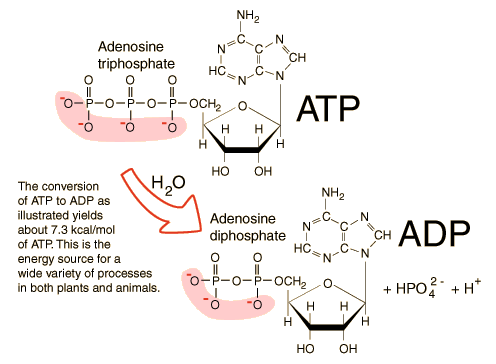Describe How Energy Is Stored in an Atp Molecule
This occurs when a molecule of adenosine diphosphate ADP uses the energy released during cellular respiration to bond with a third phosphate group becoming a molecule of ATP. Adenosine 5-triphosphate or ATP is the principal molecule for storing and transferring energy in cells.

Where Is The Energy Stored In Atp Molecules Socratic
In a process called cellular respiration chemical energy in food is converted into chemical energy that the cell can use and stores it in molecules of ATP.

. This energy currency of the cell is produced during cellular respiration where a digested simple molecule of food is utilized. Energy is stored as stored chemical energy in the bonds between phosphate groups in the ATP molecules. The bond between the second phosphate and last phosphate groups yields the most energy about seven kilocalories per mole.
The energy within an ATP molecule is stored in the phosphate bonds of the ATP. In cells ATP is the only molecule cells can use for energy. Phosphoanhydride bonds link the terminal phosphates formed by the removal of water between two phosphoric acids or between a carboxylic acid and a phosphoric acid tend to have a large negative AG of hydrolysis and are thus said to be high energy bonds.
When the cell needs energy to do work ATP loses its 3rd phosphate group releasing energy stored in the bond that the cell can use to do work. The energy of the ATP molecule lies in the bonds between the phosphate groups or pyrophosphate bonds states Dr. It has a high amount of energy which is stored in the phosphate tail.
Each ATP molecule gives 7200 calories of energy. Energy stored in the phosphate bonds of an ATP molecule. The energy released due to the breakdown of sugar molecules is stored in ATP.
Once the last phosphate. That is ATP is able to store and transport chemical energy within cellsATP also plays an important role in the synthesis of nucleic acids. This energy is stored in the form of phosphate bonds.
How is energy released from ATP. Number of membranes in a mitochondria. Covalent bonds between phosphates When ATP hydrolysis an exergonic reaction provides the energy for a simultaneous endergonic reaction this is an example of_reactions.
An ATP molecule consists of a 5-carbon sugar called ribose a nitrogen base called adenine and three phosphate groups covalently. The Adenosine triphosphate ATP molecule is the nucleotide known in biochemistry as the molecular currency of intracellular energy transfer. Converts the energy in food to an energy-carrying molecule A-2 B-1 C-3 Select molecules that have stored potential energy and that can be used in aerobic respiration to generate ATP.
Has three phosphate group when ever energy is required and the bond between the last phosphate group is broken with rest of the ATP molecule it results in tremendous amount of energy in the process. ATP hydrolysis ATP h2O - ADP P energy. The process of phosphorylating ADP to form ATP and removing a phosphate from ATP to form ADP in order to store and release energy respectively is known as the ATP cycle.
ATP is an immediate source of energy for cellular work. When ATP is hydrolyed and the bonds between phosphates are broken the energy is released. An ATP molecule is unstable and primed to release energy because its _____ groups are negatively charged and repel each other.
In a process called cellular respiration chemical energy in food is converted into chemical energy that the cell can use and stores it in molecules of ATP. All living things use ATP. Middle of the mitochondria.
When one phosphate group is removed by breaking a phosphoanhydride bond in a process called hydrolysis energy is released and ATP is converted to adenosine diphosphate ADP. Where is the energy stored in ATP. ATP Adenosine triphosphate.
When ATP is broken down into ADP adenosine diphosphate and inorganic phosphate energy is released. It is the main energy currency of the cell and it is an end product of the processes of photophosphorylation adding a phosphate group to a molecule using energy from light cellular respiration and fermentation. Name 3 molecules that can store energy for organisms.
Adenosine triphosphate also known as ATP is a molecule that carries energy within cells. In this form energy can be stored at one location then moved from one part of the cell to another where it can be released to drive other biochemical reactions. High energy bonds are.
This article guides you to learn about how energy is stored in Adenosine Triphosphate ATP. In the bonds between the phosphate groups. Where is the most energy stored in an ATP molecule.
Once after the energy is produced by the ATP. When ADP and inorganic phosphate are joined to form ATP energy is stored. ATP glucose lipids Glycogen.
It is used by various enzymes and structural proteins in cellular processes like biosynthetic reactions cell divisions etc. Folds in the mitochondria. Mike Farabee of Estrella Mountain Community College.
This molecule provides energy for various life processes without which life cannot exist. How is this energy stored in ATP released. The ATP molecule can store energy in the form of a high energy phosphate bond joining the terminal phosphate group to the rest of the molecule.
This special carrier of energy is the molecule adenosine triphosphate or ATP. Energy is stored in the bonds between the phosphate groups PO4 of the ATP molecule.
How Is Energy Stored And Released By The Atp Quora

Question Video Identifying The Energy Source In The Chemical Bonds Of Atp Nagwa

No comments for "Describe How Energy Is Stored in an Atp Molecule"
Post a Comment